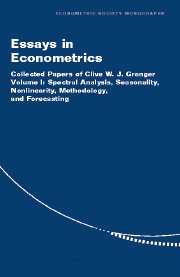Book contents
- Frontmatter
- Contents
- Acknowledgments
- List of Contributors
- Introduction
- 1 The ET Interview: Professor Clive Granger
- PART ONE SPECTRAL ANALYSIS
- PART TWO SEASONALITY
- PART THREE NONLINEARITY
- PART FOUR METHODOLOGY
- PART FIVE FORECASTING
- 17 Estimating the Probability of Flooding on a Tidal River
- 18 Prediction with a Generalized Cost of Error Function
- 19 Some Comments on the Evaluation of Economic Forecasts
- 20 The Combination of Forecasts
- 21 Invited Review: Combining Forecasts – Twenty Years Later
- 22 The Combination of Forecasts Using Changing Weights
- 23 Forecasting Transformed Series
- 24 Forecasting White Noise
- 25 Can We Improve the Perceived Quality of Economic Forecasts?
- 26 Short-Run Forecasts of Electricity Loads and Peaks
- Index
21 - Invited Review: Combining Forecasts – Twenty Years Later
Published online by Cambridge University Press: 06 July 2010
- Frontmatter
- Contents
- Acknowledgments
- List of Contributors
- Introduction
- 1 The ET Interview: Professor Clive Granger
- PART ONE SPECTRAL ANALYSIS
- PART TWO SEASONALITY
- PART THREE NONLINEARITY
- PART FOUR METHODOLOGY
- PART FIVE FORECASTING
- 17 Estimating the Probability of Flooding on a Tidal River
- 18 Prediction with a Generalized Cost of Error Function
- 19 Some Comments on the Evaluation of Economic Forecasts
- 20 The Combination of Forecasts
- 21 Invited Review: Combining Forecasts – Twenty Years Later
- 22 The Combination of Forecasts Using Changing Weights
- 23 Forecasting Transformed Series
- 24 Forecasting White Noise
- 25 Can We Improve the Perceived Quality of Economic Forecasts?
- 26 Short-Run Forecasts of Electricity Loads and Peaks
- Index
Summary
Abstract
The combination of forecasts is a simple, pragmatic and sensible way to possibly produce better forecasts. Simple extensions of the original idea involve the use of various available “forecasts” even if some are rather inefficient. Some unsolved questions relate to combining forecasts with horizons longer than one period. More complicated extensions are associated with “encompassing” and the combination of confidence intervals or quantiles. The relevance of information sets is emphasized in both the underlying theory and the interpretation of combinations.
Keywords: combinations, forecasts, integrated, information sets, encompassing, quantiles.
THE BEGINNINGS
In 1963 Barnard published a paper comparing forecasts made by the then-novel Box–Jenkins (BJ) modelling procedure with those from the more venerable, exponentially weighted, moving average or adaptive forecasting methods, finding BJ to be superior. Barnard might have concluded – although he did not – that the better method should be retained and the loser discarded. However, it was observed that a simple average of the two forecasts outperformed each of them. The obvious extension was to ask if a weighted combination of the forecasts would be even better. This possibility was explored by Bates and the author (henceforth, BG) in our 1969 paper, which considered the theory of how the weights should be chosen optimally and contained a practical investigation of how estimates of these and some suboptimal weights actually performed. The weights on the two forecasts were chosen to add to one, on the assumption that each forecast was unbiased, making the combination unbiased.
Information
- Type
- Chapter
- Information
- Essays in EconometricsCollected Papers of Clive W. J. Granger, pp. 411 - 419Publisher: Cambridge University PressPrint publication year: 2001
Accessibility standard: Unknown
Why this information is here
This section outlines the accessibility features of this content - including support for screen readers, full keyboard navigation and high-contrast display options. This may not be relevant for you.Accessibility Information
- 1
- Cited by
